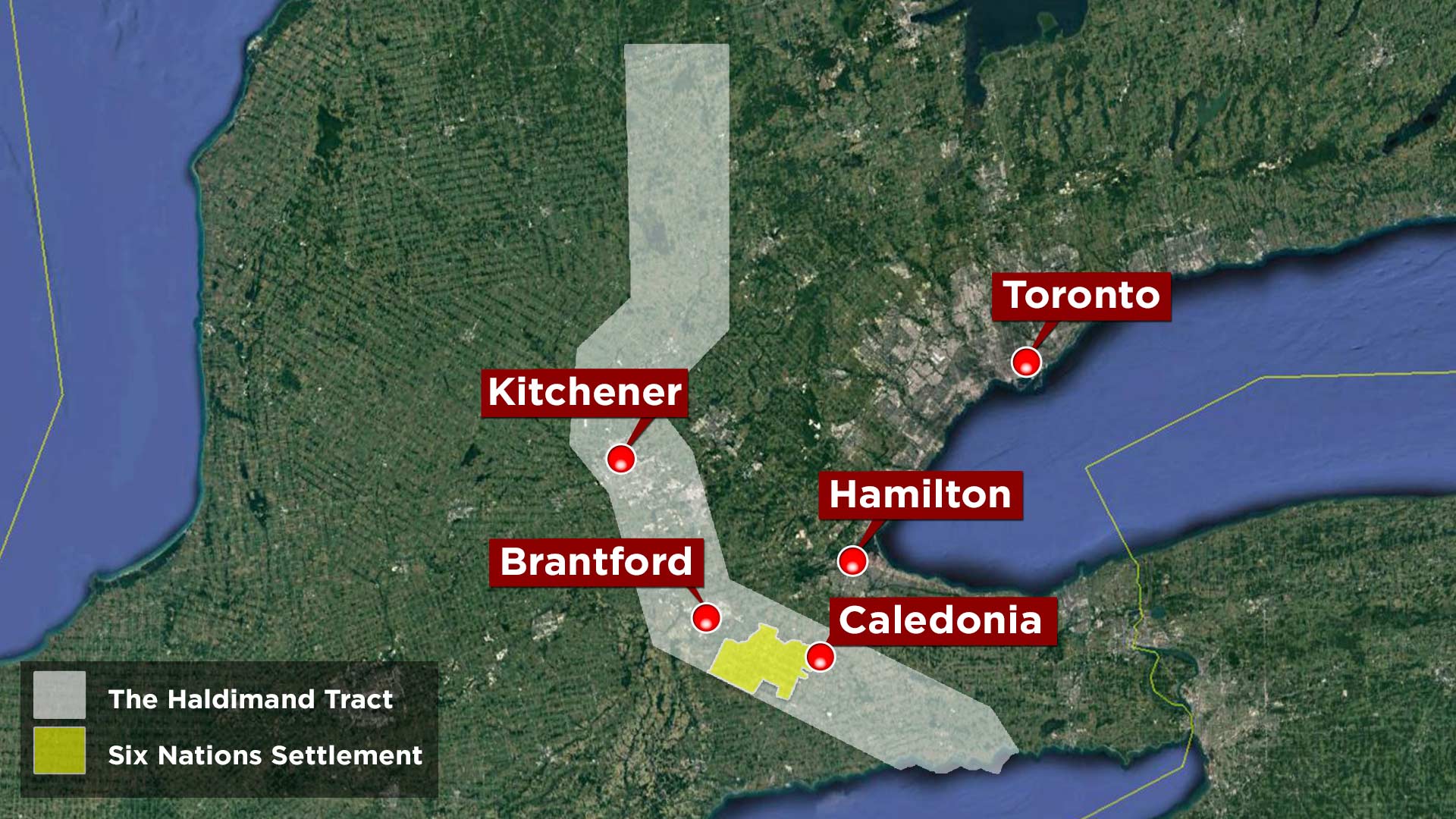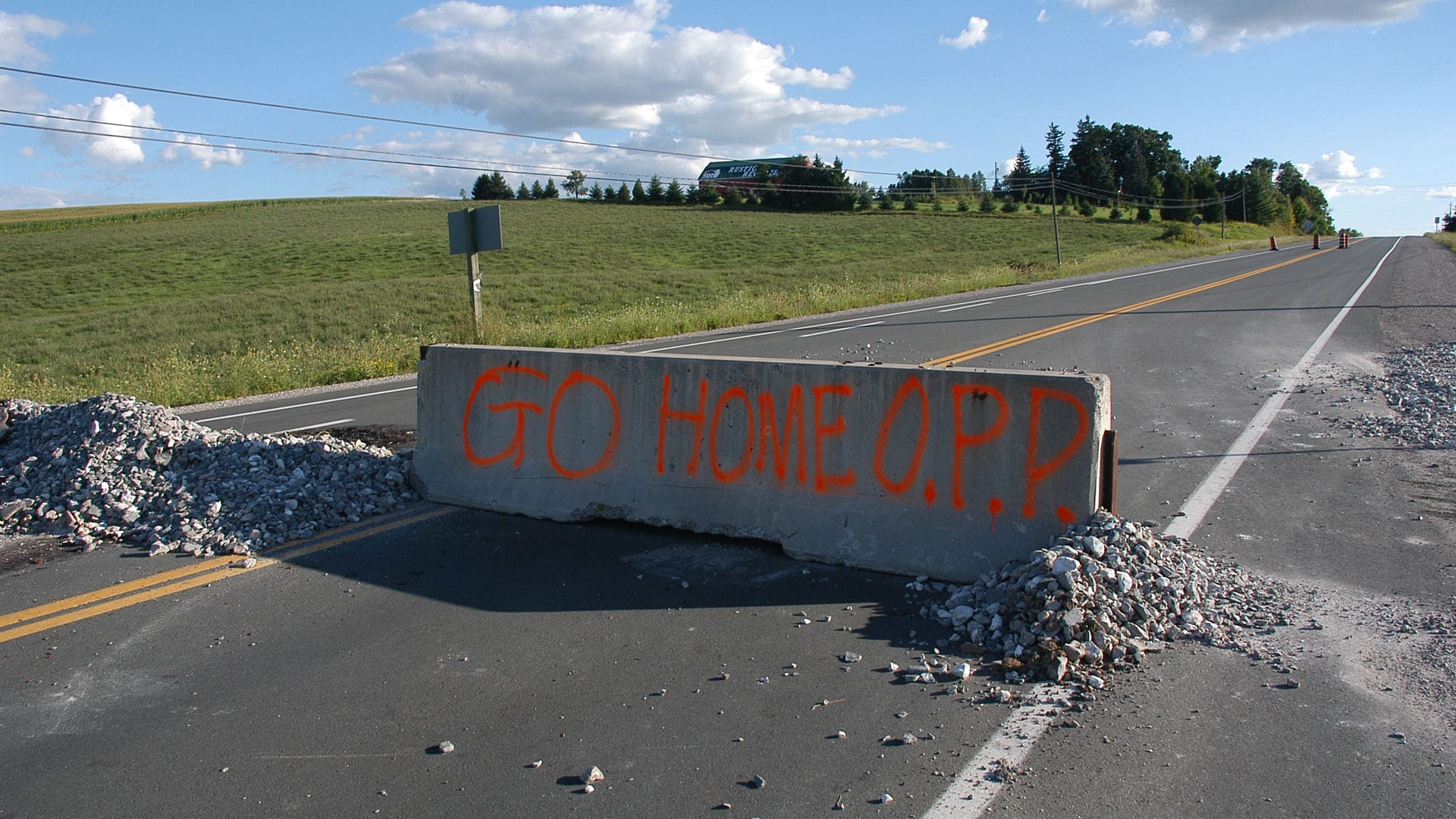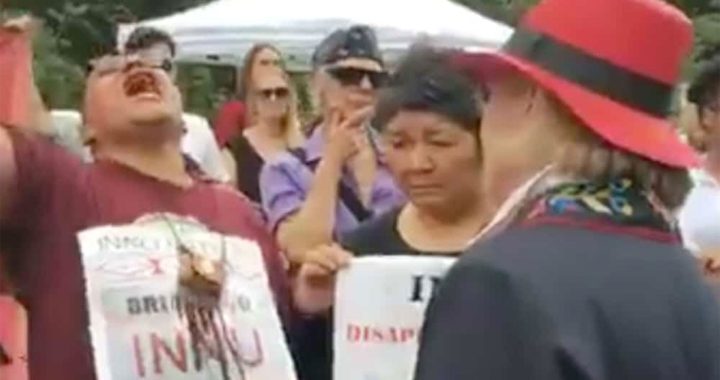
Signs at the entrance to the McKenzie Meadows construction site reclaim the subdivision as unceded Six Nations land. Photo: Brett Forester/APTN
In late July about a dozen people walked on to a construction site at 1535 McKenzie Rd. in Caledonia, Ont., roughly 100 km southwest of Toronto.
They opposed the development of a subdivision on the outskirts of the town’s urban area, reclaiming the land as unsurrendered territory of the Six Nations Confederacy (also known as the Iroquois or Haudenosaunee).
But the roots of the land struggle along the sinuous banks of the Grand River go back centuries.
Here is a non-comprehensive timeline of some important dates in the conflict.
Allies of the Crown
- 1775-83 The Six Nations ally with the British during the American Revolution, losing a significant piece of their territory in present day New York as a result.
- 1784 Sir Frederick Haldimand, governor of Quebec, grants 950,000 acres (acquired by treaty from the Mississauga) to the Six Nations as a settlement: “six miles deep” from either side of the Grand River. It is commonly called the Haldimand Tract.
- 1793 Haudenosaunee leaders say the Haldimand Proclamation grants them freehold title to the land. The Crown disagrees.
- Lieutenant governor of Upper Canada, John Graves Simcoe, issues a patent upholding the Proclamation. But the new patent doesn’t include the Grand River headwaters, reducing the territory size.

Six Nations oppose influx of settlers
- Early 1800s Mohawk leader Thayendanegea (Joseph Brant) authorizes sale and lease of some parcels. Many settlers are squatters. Six Nations petition the Crown and ask for their removal.
- 1830s Crown approaches the Six Nations to build a “plank road” through their territory. Six Nations agree to lease the land. (The plank road later becomes Argyle St. and Highway 6 in Caledonia, where several blockades and protests occur throughout the 21st century)
- 1835 A founding figure, Ranald McKinnon arrives along with the Grand River Navigation Company in future-Caledonia. Squatting on Haldimand Tract increases.
- 1841 Samuel Jarvis, chief superintendent of Indian Affairs, tells the Six Nations that the Crown will not forcefully evict the 2,000 squatters. Caledonia’s population is about 300.
- He proposes that the Haudenosaunee surrender their lands to the Crown to prevent further encroachment in return for cash and a 20,000-acre reserve.
- The Crown obtains the disputed “general surrender” under those terms after six chiefs sign the document. Fifty-one chiefs and warriors protest the surrender a month later, saying Jarvis coerced or manipulated those who signed.
- 1850 Crown passes a proclamation setting the Six Nations reserve at its current size, approximately 47,000 acres (19,020 hectares) or less than 5 per cent of the original Haldimand Tract.
- 1853 Crown sells the future McKenzie Meadows land to Thomas Nicholls. The grant explains that the parcel in Oneida Township is Six Nations reserve land and that proceeds will go to the Six Nations.

Traditional government banned, land claims begin
- 1923 Deskaheh (Levi General), a Cayuga hereditary chief, travels through Europe seeking international recognition for the Haudenosaunee.
- 1924 RCMP depose the traditional government and install an Indian Act elective system. Police seize wampums and lock chiefs out of their council hall.
- 1927 Government makes it illegal for bands under the Indian Act to hire lawyers to advance legal claims against Canada.
- 1959 RCMP quash a revolt by hereditary chiefs who attempt to reinstate traditional government.
- 1980-95 The Six Nations launch 29 land claims against the Crown.
- Claim No. 5 includes the Douglas Creek Estates land, which was reclaimed in 2006.
- Claim No. 16 is for the former Oneida Township, which includes McKenzie Meadows.
- Crown closes all claims after the Six Nations sue Canada and Ontario for an accounting of all cash, land or assets owed as a result of alleged misdealing along the Grand River.

Douglas Creek Estates conflict
- 2003 A developer submits a draft subdivision plan for McKenzie Meadows.
- 2004-05 Six Nations pause their lawsuit to explore negotiations with Canada and Ontario.
- 2006 Six Nations people occupy the Douglas Creek Estates (DCE) subdivision, renaming it Kanonhstaton (Mohawk for “The Protected Place”). It becomes one of the longest, most expensive and bitterest First Nations land occupations in Canadian history, marked by violent police raid and clashes between Six Nations people and Caledonians.
- Ontario buys the land from Henco Industries to cool tensions. The land remains in Ontario’s name held in trust.
- 2007-08 Canada, Ontario and Six Nations hold talks on the conflict. The traditional system, the Haudenosaunee Confederacy Chiefs Council (HCCC), leads the way.
- 2009 Talks sputter. The Six Nations reactivate their accounting claim, led by the elected council. A trial is scheduled for October 2022, the council says.
- 2013-14 Direct action, protests, blockades and occupations resume. The Confederacy constructs a large gate, emblazoned with purple and white Haudenosaunee flags across it, at the entrance to Kanonhstaton.
- Community consultation rejects McKenzie Meadows project. Elected council decides not to support it.
- 2015 McKenzie Meadows developer Foxgate Developments acquires land from a numbered company.

McKenzie Meadows dispute
- July 19, 2020 Six Nations members occupy a construction site at 1535 McKenzie Rd., renaming it 1492 Land Back Lane.
- The subdivision is across town but linked to Kanonhstaton through an hydro and pipeline easement access road.
- July 30 Foxgate Developments obtains an injunction ordering the camp dismantled.
- Aug. 5 The Ontario Provincial Police (OPP) enforce the injunction. Police use a taser and rubber bullets to clear the property and arrest nine people.
- Six Nations people respond with a tire fire and barricade outside the gates of Kanonhstaton. People shut down CN tracks and blockade the Highway 6 bypass.
- Aug. 7 Justice John Harper extends Foxgate’s injunction. He also grants an injunction to Haldimand County that orders the road blocks dismantled.
- Aug. 15 Confederacy chiefs publicly support the occupation.
- Aug. 19 Federal ministers Marc Miller and Carolyn Bennett offer to resume negotiations in a letter sent to traditional and elected chiefs.
- Aug. 21 The community dismantles most of the barricades. The Highway 6 bypass reopens. Trains start moving.
- People erect a support camp on Kanonhstaton, across the street from access road into McKenzie Meadows.
- Aug. 22 The last of the main blockade outside Kanonhstaton is removed.
- Aug. 25 Court extends both injunctions. Spokesperson for the action Skyler Williams is identified as a “protest leader” and named on the injunction.
- Sept. 16 Arrests continue. OPP release the names of 22 people charged in connection to the occupation or blockades.
- Oct. 9 Court extends injunctions again. A police affidavit says police are wary of removing camp occupants a second time, calling force “a blunt instrument that cannot resolve the issues underlying land disputes of this nature.”
- Harper gives Williams, who self-represents in court, an ultimatum: Dismantle the camp and be allowed to participate in future court hearings, or flout the order and be preventing from attending.










